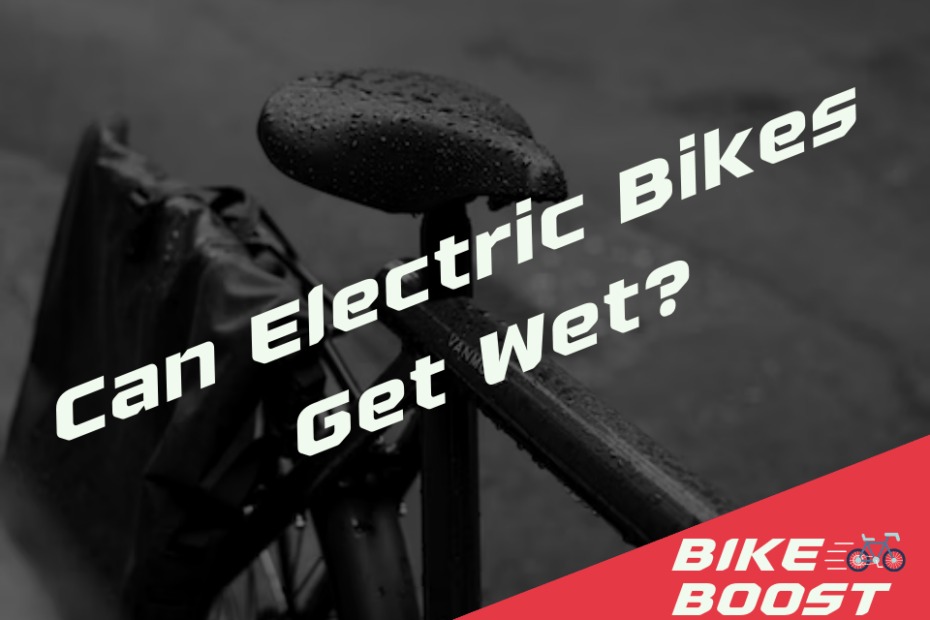We love writing these guides for you and sometimes we are compensated when you use one of our links to buy a product. This doesn’t impact the final price you pay. If you want to learn more about how this works, please see our Affiliate Disclosure page.
Electric bikes, also known as e-bikes, have gained tremendous popularity in recent years. These innovative vehicles offer an eco-friendly and efficient mode of transportation. However, as with any technological device, it’s important to understand their limitations and how they perform under various conditions. One common concern that arises among e-bike enthusiasts is whether electric bikes can get wet. Let’s dive into this topic and uncover the truth behind riding e-bikes in wet conditions.
Key Takeaways:
- Electric bikes have varying levels of water resistance, so it’s essential to check the manufacturer’s specifications for your specific model.
- Taking precautions like reducing speed, avoiding deep puddles, and drying off your e-bike after riding in wet conditions can help protect it from water damage.
- Regular maintenance, proper storage, and periodic inspections are key to ensuring the longevity and optimal performance of your electric bike in wet conditions.
The Waterproof Question
When it comes to electric bikes, the question of water resistance is of utmost importance. After all, encountering rain showers or navigating through puddles is inevitable for many riders. So, can electric bikes withstand wet conditions? The answer lies in the design and build quality of the e-bike components.
At BikeBoost.org, we are committed to providing helpful guides and insights for bicycle enthusiasts. Check out our informative articles on turning your bike into an electric bike and charging an e-bike while riding to enhance your biking experience!
Understanding Water Resistance Levels
Electric bikes are equipped with a variety of components, including the motor, battery, controller, and wiring. Each of these components may have different levels of water resistance. While some e-bikes are designed to be fully waterproof, others may have certain limitations when it comes to exposure to water.
Pro Tip: It’s crucial to refer to the manufacturer’s specifications and guidelines for your specific electric bike model to understand its water resistance capabilities.
Shielding the Critical Components
To protect the vital components of an electric bike from water damage, manufacturers employ various techniques. These include:
- Sealed Battery Compartments: E-bikes often have sealed compartments to house the battery securely, protecting it from water intrusion.
- Waterproof Wiring and Connectors: Electric bikes incorporate waterproof wiring and connectors to prevent short circuits and ensure optimal functionality even in wet conditions.
- Motor Casing: The motor, being a critical component, is usually enclosed in a robust casing, offering protection against moisture and splashes.
Interested in learning more about the intricacies of electric bike functionality? Our detailed article on how electric bikes work provides a comprehensive overview!
Riding Precautions in Wet Conditions
While many electric bikes can withstand light rain or damp environments, it’s important to exercise caution and take certain precautions when riding in wet conditions. Here are some helpful tips to keep in mind:
- Reduce Speed: Wet surfaces can be slippery, affecting traction. It’s advisable to ride at a moderate speed to maintain stability and minimize the risk of accidents.
- Avoid Deep Puddles: Riding through deep puddles can submerge crucial components of your e-bike, potentially causing damage. Whenever possible, choose alternate routes to steer clear of standing water.
- Dry off After Riding: Once you’ve completed your ride in wet conditions, it’s essential to dry off your electric bike thoroughly. Wipe down the surfaces and components to prevent water from seeping into sensitive areas.
Looking for expert advice on how to choose between an electric bike and an electric scooter? Explore our insightful article on comparing electric bikes and electric scooters to make an informed decision!
Maintenance and Care
To ensure the longevity and optimal performance of your electric bike, regular maintenance and proper care are essential. Here are a few maintenance tips to keep your e-bike in top shape:
- Charging and Battery Care: Follow the manufacturer’s guidelines for charging your e-bike’s battery and maintaining its health. Proper charging practices contribute to overall performance and longevity.
- Periodic Inspections: Conduct regular inspections of your electric bike’s components, including cables, connectors, and seals, to identify any signs of wear or water damage. Address any issues promptly to prevent further complications.
- Store in a Dry Environment: When not in use, it’s recommended to store your electric bike in a dry environment to minimize exposure to moisture.
Curious about how many calories you can burn while riding an electric bike? Check out our insightful article on calorie burn on electric bikes to discover the health benefits of this exciting mode of transportation!
Embrace the Ride, Rain or Shine!
While electric bikes can generally handle light rain or wet conditions, it’s crucial to be mindful of their limitations and take appropriate precautions. By understanding your e-bike’s water resistance capabilities and following best practices, you can enjoy the thrill of riding while ensuring the longevity of your electric bike.
Remember, if you have specific questions or concerns about your electric bike model, it’s always best to consult the manufacturer or refer to their official documentation for accurate and detailed information.
At BikeBoost.org, we’re dedicated to providing comprehensive guides and resources to assist you in navigating the world of electric bikes. From choosing the right electric bike to understanding insurance options, we’ve got you covered! Explore our articles on selecting the perfect electric bike and insuring an electric bike to make informed decisions. Happy riding!
FAQs
Can I ride my electric bike in heavy rain?
While many electric bikes have water-resistant components, it’s generally best to avoid riding in heavy rain to prevent potential damage.
Are electric bikes waterproof?
Electric bikes vary in their water resistance levels. It’s important to consult the manufacturer’s specifications to understand the waterproof capabilities of your specific model.
Can I wash my electric bike with water?
It’s generally safe to wash your electric bike with water, but avoid directing high-pressure water at sensitive components such as the motor and battery.
How do I protect my electric bike from water damage?
To protect your e-bike, dry it off after riding in wet conditions, store it in a dry place, and conduct regular inspections to identify any signs of water damage.
Can I ride my electric bike through puddles?
It’s best to avoid riding through deep puddles as they can submerge critical components and potentially cause damage to your electric bike.
How often should I check my electric bike for water damage?
Regularly inspect your e-bike for any signs of water damage, especially after riding in wet conditions. Look for corrosion, moisture accumulation, or unusual functioning of components.
Andy is an avid cyclist who enjoys nothing more than a ride out in the hills. Competing in track, road, time trial and mountain bike events in the past, he prefers slower rides out with his family these days.

